An Efficient Hybrid Particle Swarm and Gradient Descent Method for the Estimation of the Hosting Capacity of Photovoltaics by Distribution Networks
Abstract
1. Introduction
2. Hybrid PSO-GD Algorithm
2.1. Generic Particle Swarm Optimization
2.2. Generic Gradient Descent Algorithm
2.3. Proposed Hybrid PSO-GD Algorithm
2.4. Evaluation of Particles for the Solution Search
3. PVHC Estimation Problem Formulation and the PSO-GD Solution Approach
3.1. Problem Formulation
3.2. Voltage-Var Control (VVC) by PV Inverter
3.3. Implementation of PSO-GD for Estimating DN’s PVHC
4. Simulation Results and Discussions
4.1. PVHC of IEEE 33 Bus Test RDN with/without VVC
4.2. Comparison of PSO-GD with Other Meta-Heuristic Methods
4.3. Stability Analysis of PSO-GD
5. Conclusions
Author Contributions
Funding
Data Availability Statement
Conflicts of Interest
References
- Jacobson, M.Z.; Delucchi, M.A.; Cameron, M.A.; Manogaran, I.P.; Shu, Y.; Krauland, A.-K.V. Imapcts of Green New Deal Energy Plans on Grid Stability, Costs, Jobs, Health, and Climate in 143 Countries. One Earth 2019, 1, 449–463. [Google Scholar] [CrossRef]
- Gielen, D.; Boshell, F.; Saygin, D.; Bazilian, M.D.; Wagner, N.; Gorini, R. The Role of Rennewable Energy in the Global Energy Transformation. Energy Strategy Rev. 2019, 24, 38–50. [Google Scholar] [CrossRef]
- Hamidreza Sadeghian, Z.W. A Novel Impact-assessment Framework for Distributed PV installations in low-voltage Secondary Networks. Renew. Energy 2020, 147, 2179–2194. [Google Scholar] [CrossRef]
- Schmela, M.; Hermetsberger, W.; Chianetta, G. Global Market Outlook for Solar-Power 2020–2014; SolarPower Europe: Brussels, Belgium, 2020. [Google Scholar]
- Mulenga, E.; Bollen, M.H.J.; Etherden, N. Solar PV Stochastic Hosting Capacity in Distribution Networks Considering Aleatroy and Epistemic Uncertainties. Int. J. Electr. Power Energy Syst. 2021, 130, 106928. [Google Scholar] [CrossRef]
- Bollen, M.H.J.; Häger, M. Power Quality: Interactions between Distributed Energy Resources, the Grid and Other Customers. In Proceedings of the 1st International Conference on Renewable Energy Sources and Distibuted Energy Resources, Brussels, Belgium, 1–3 December 2004. [Google Scholar]
- Bertini, D.; Moneta, D.; Carneiro, J.S.d.A. Hosting Capacity of Italian LV Distribution Networks. In Proceedings of the CIRED: 21st International Conference on Electricity Distribution, Frankfurt, Germany, 6–9 June 2011. [Google Scholar]
- Breker, S.; Claudi, A.; Sick, B. Capacity of Low-Voltage Grids for Distributed Generation: Classification by Means of Stochastic Simulations. IEEE Trans. Power Syst. 2015, 30, 689–700. [Google Scholar] [CrossRef]
- Prusty, R.; Jena, D. A critical Review on Probabilistic Load Flow Studies in Uncertainty Constrained Power Systems with Photovoltaic Generation and a New Approach. Renew. Sustain. Energy Rev. 2017, 69, 1286–1302. [Google Scholar] [CrossRef]
- Behravesh, V.; Keypour, R.; Foroud, A.A. Stochastic Analysis of Solar Rooftop and Wind Hybrid Generation Systems and Their Impact on Voltage behavior in Low Voltage Distribution Systems. Sol. Energy 2018, 166, 317–333. [Google Scholar] [CrossRef]
- Mulenga, E.; Bollen, M.H.J.; Etherden, N. A review of Hosting Capacity Quantification Methods for Photovoltaics in Low-Voltgae Distribution Grids. Electr. Power Energy Syst. 2020, 115, 105445. [Google Scholar] [CrossRef]
- Munikoti, S.; Abujubbeh, M.; Kumarsinh Jhala, B.N. A Novel Framework for Hosting Capacity Analysis with Spacio-Temporal Probabilistic Voltage Sensistivity Analysis. Int. J. Electr. Power Energy Syst. 2022, 134, 107426. [Google Scholar] [CrossRef]
- Zulu, E.; Hara, R.; Kita, H. A Flexible Stochastic PV Hosting Capacity Framework Considering Network over-Voltage Tolerance. Energy Rep. 2023, 9 (Suppl. S1), 529–538. [Google Scholar]
- Dubey, A.; Santoso, S. On Estimation and Sensitivity Analysis of Distribution Circuit’s Photovoltaic Hosting Capacity. IEEE Trans. Power Syst. 2017, 32, 2779–2789. [Google Scholar] [CrossRef]
- Samet, H.; Khorshidsavar, M. Analytic Time-series Load Flow. Renew. Sustain. Energy Rev. 2018, 82, 3886–3899. [Google Scholar] [CrossRef]
- Emmanuel, M.; Rayudu, R. The Impact of Single-phase Grid-connected Distributed Photovoltaic Systems on the Distribution Network using P-Q and P-V Models. Electr. Power Energy Syst. 2017, 91, 20–33. [Google Scholar] [CrossRef]
- Ismael, S.M.; Aleem, S.H.A.; Abdelaziz, A.Y.; Zobaa, A.F. Sate-of-the-Art of Hosting Capacity in Modern Power Systems with Distributed Generation. Renew. Energy 2019, 130, 1002–1020. [Google Scholar] [CrossRef]
- Heslop Simon, I.M.J.F.S.L. Method for Determining a PV Generation Limit on Low-Voltage Feeders for Evenly Distributed PV and Load. Energy Procedia 2014, 57, 207–216. [Google Scholar] [CrossRef]
- Stetz, T.; Kraiczy, M.; Diwold, M.B.K.; Bletterie, B.; Mayr, R.B.C.; Noone, B. High penetration PV in Local Distribution Grids-Outcomes of the IEA PVPS Task 14 Subtask 2. In Proceedings of the 29th European Photovotaic Solar Energy Conference and Exhibition (EU PVSEC 2014), Amsterdam, The Netherlands, 22–26 September 2014. [Google Scholar]
- Meena, N.K.; Parashar, S.; Swarnkar, A.; Gupta, N.; Niaz, K.R. Improved Elephant Herding Optimization for Multiobjective DER Accomodation in Distribution Systems. IEEE Trans. Ind. Inform. 2018, 14, 1029–1039. [Google Scholar] [CrossRef]
- Sultana, S.; Ror, P.K. Multi-objective Quasi-oppositional Taeching-Learning based Optimization for Optimal Location of Distributed Generator in Radial Distribution Systems. Electr. Power Energy Syst. 2014, 63, 534–545. [Google Scholar] [CrossRef]
- Quadri, I.A.; Bhowmick, S.; Joshi, D. A Comprehensive Technique for Optimal Allocation of Distributed Energy in Radial Distribution Systems. Appl. Energy 2018, 211, 1245–1260. [Google Scholar] [CrossRef]
- Morad, M.H.; Abedini, M. A Combination of Genetic Algorithm and Particle Swarm Optimization for Optimal DG Location and Sizing in Distribution Systems. Electr. Power Energy Syst. 2012, 34, 66–74. [Google Scholar] [CrossRef]
- Ali, M.; Keerio, U.; Laghari, J.A. Optimal Site and Size of Distributed Generation Allocation in Radial Distribution Network Using Multi-Objective Optimi-zation. Mod. Power Syst. Clean Energy 2021, 9, 404–415. [Google Scholar] [CrossRef]
- Alanazi, M.; Memon, Z.A.; Mosavi, A. Determining Optimal Power Flow Solutions Using New Adaptive Gaussian TLBO Method. Appl. Sci. 2022, 12, 7959. [Google Scholar] [CrossRef]
- Santos, A.; Deckmann, S.; Soares, S. A Dual Augmented Lagrangian Approach for Optimal Power Flow. IEEE Trans. Power Syst. 1988, 3, 1020–1025. [Google Scholar] [CrossRef] [PubMed]
- Hermann, D.W.; William, T.F. Optimal Power Flow Solutions. IEEE Trans. Power Appar. Syst. 1968, PAS-87, 1866–1876. [Google Scholar]
- Rusell, E.; James, K. Particle Swarm Optimization. In Proceedings of the IEEE Conference on Neural Networks (ICNN’95), Perth, Australia, 27–1 December 1995. [Google Scholar]
- Craig, R.W. Flocks, Herds, and Schools: A Distributed Behavioral Model. Comput. Graph. 1987, 21, 25–34. [Google Scholar]
- El-Hawary, M.E.; Lee, K.Y.; El-Sharkawi, M. Modern Heuristic Optimization Techniques: Theory and Applications to Power Systems; IEEE Press: Piscataway, NJ, USA, 2008; pp. 71–87. [Google Scholar]
- Rusell, E.; James, K. A Discreet Binary Version of the Particle Swarm Optimization Algorithm. In Proceedings of the 1997 Conference on Systems, Manufacturing, and Cybernetics (SMC’97), Gaithersburg, MD, USA, 22–25 September 1997. [Google Scholar]
- Yoshida, H.; Kawata, K.; Fukuyama, Y.; Shinichi Takayama, Y.N. A Particle Swarm Optimization for Reactive Power and Voltage Control Considering Voltage Security Assessment. IEEE Trans. Power Syst. 2001, 15, 1232–1239. [Google Scholar] [CrossRef]
- Khosla, T.; Verma, O.P. An Adaptive Hybrid Particle Swarm Optimizer for Constrained Optimization Problem. In Proceedings of the International Conference in Advances in Power, Signal and Information Technology, Bhubaneswar, India, 8–10 October 2021. [Google Scholar]
- Zaman, H.R.R.; Gharehchopogh, F.S. An Improved Particle Swarm Optimization Algorithm for Solving Continous Optimization Problems. Eng. Comput. 2021, 10, 136. [Google Scholar]
- Noel, M.M. A New Gradient-based Particle Swarm Optimization Algorithm for Accurate Computation of Global Minimum. Appl. Soft Comput. 2012, 12, 353–359. [Google Scholar] [CrossRef]
- Adam, C.; Rafic, Y.; Jean, P.; Adrian, I. A Constraint-Handling Technique for Genetic Algorithms Using a Violation Factor. J. Comput. Sci. 2016, 12, 350–352. [Google Scholar]
- Priem, R.; Bartoli, N.; Diouane, Y.; Sgueglia, A. Upper Trust Bound Feasibility Criterion for Mixed Constrained Bayesian Optimization with Application to Aircraft Design. Aerosp. Sci. Technol. 2020, 105, 105980. [Google Scholar] [CrossRef]
- Noureen, A.; Mashwani, W.K.; Rehman, F.; Sagheer, M.; Shah, H.; Asim, M. Constrained Optimization Based on Hybrid Version of Superiority of Feasibility Solution Strategy. Soft Comput. 2022, 26, 8117–8132. [Google Scholar] [CrossRef]
- Teke, G.; Kim, C.-H.; Samuel, A.; Kim, J.-S.; Song, J.-S. Optimal Smart Inverter Control for PV and BESS to Improve PV Hosting Capacity for DN using Slime Mould Algorithm. IEEE Accsess 2021, 9, 52164–52176. [Google Scholar]
- Narang, J.; Berdner, J.; Boemer, J.C.; Enayati, B.; Fox, B.; Siira, M.; Vartanian, C.K. IEEE 1547 Standard for Interconnection and Interoperability of Distributed Energy Re-Sources with Associated Electric Power Systems Interfaces; IEEE Press: Piscataway, NJ, USA, 2020. [Google Scholar]
- Khaire, U.M.; Dhanalakshami, R. Stability Investigation of Improved Whale Optimization Algorithm in Feature Selection. IEEE Trans. 2020, 39, 286–300. [Google Scholar] [CrossRef]
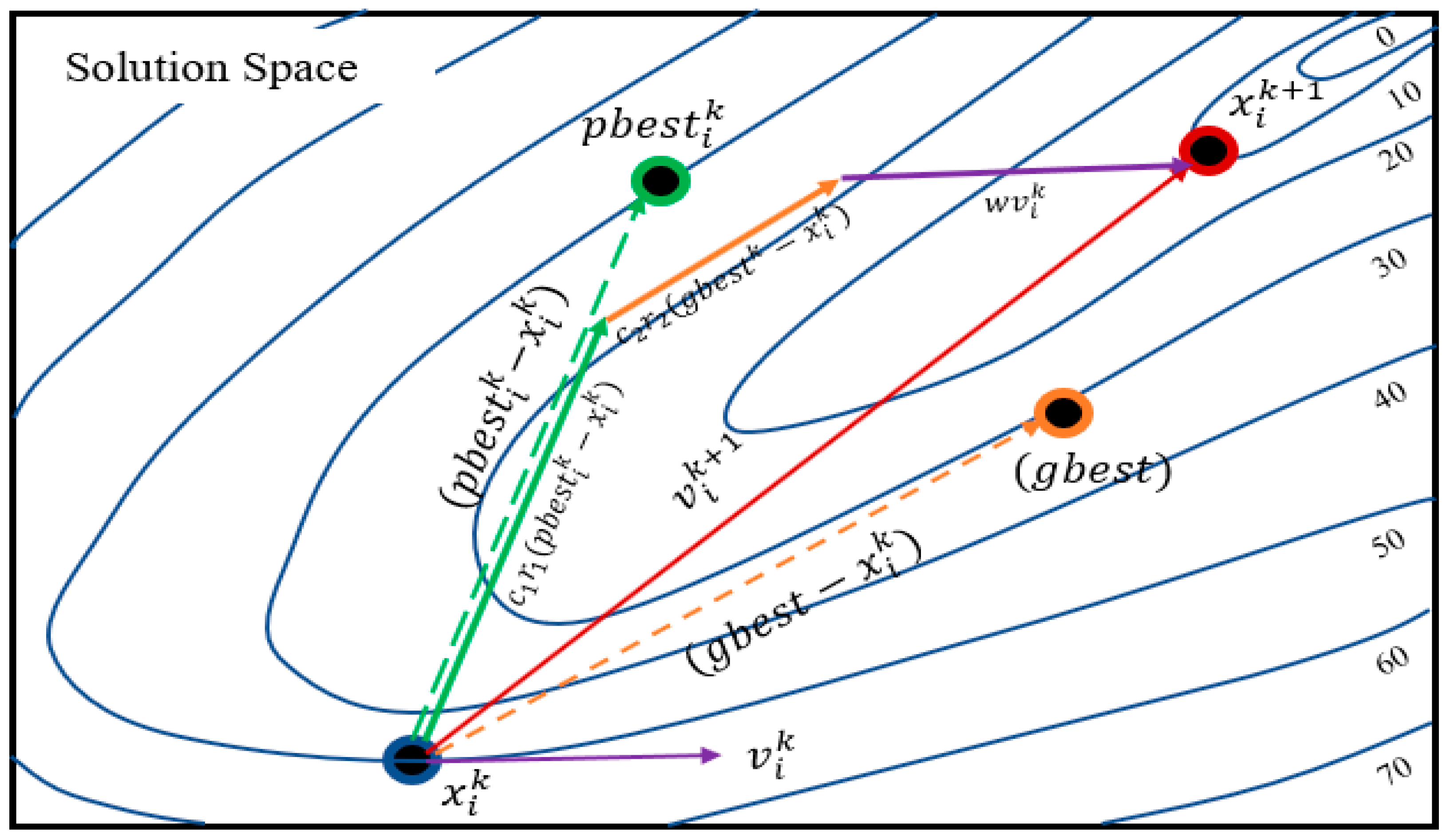
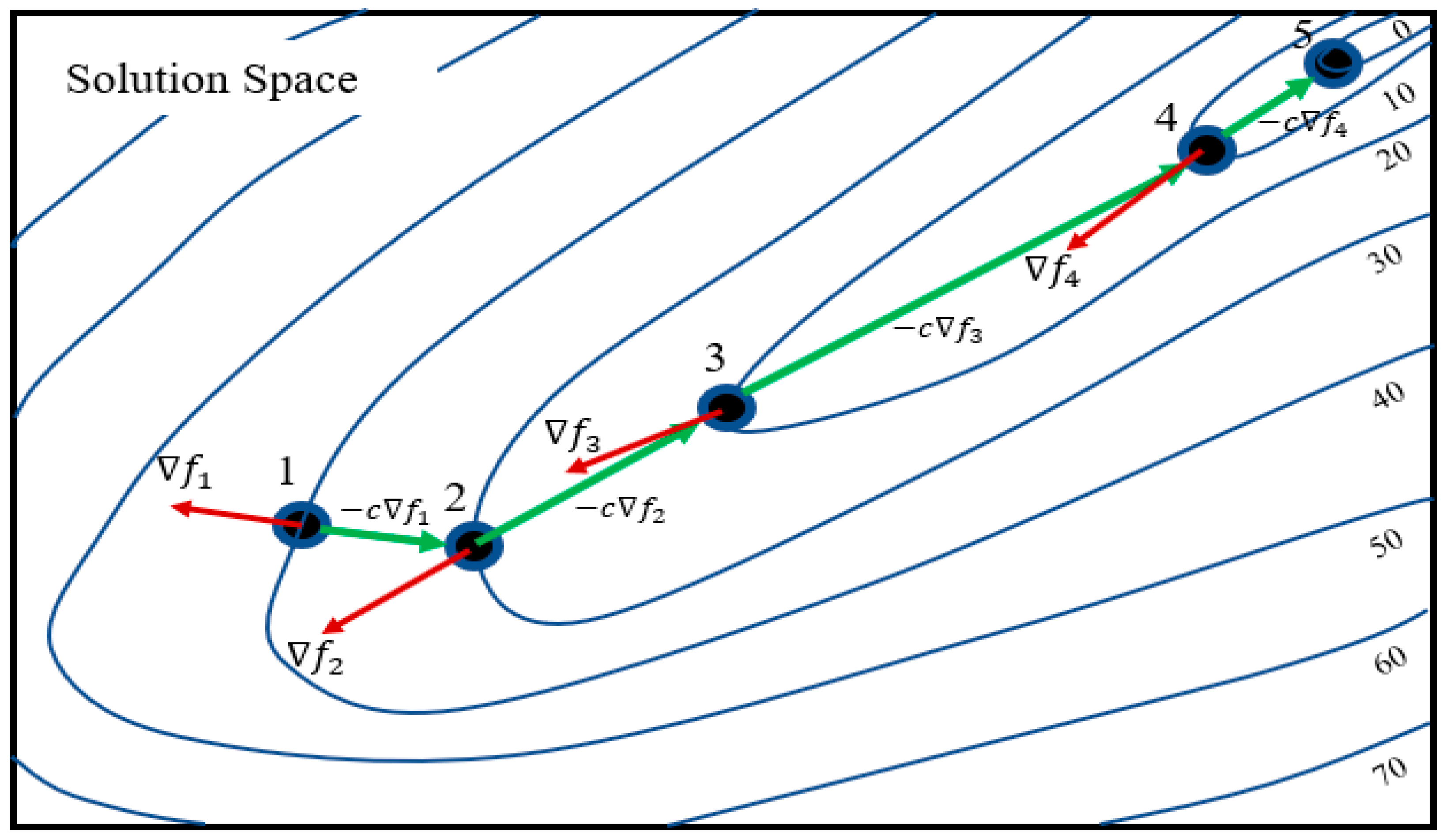

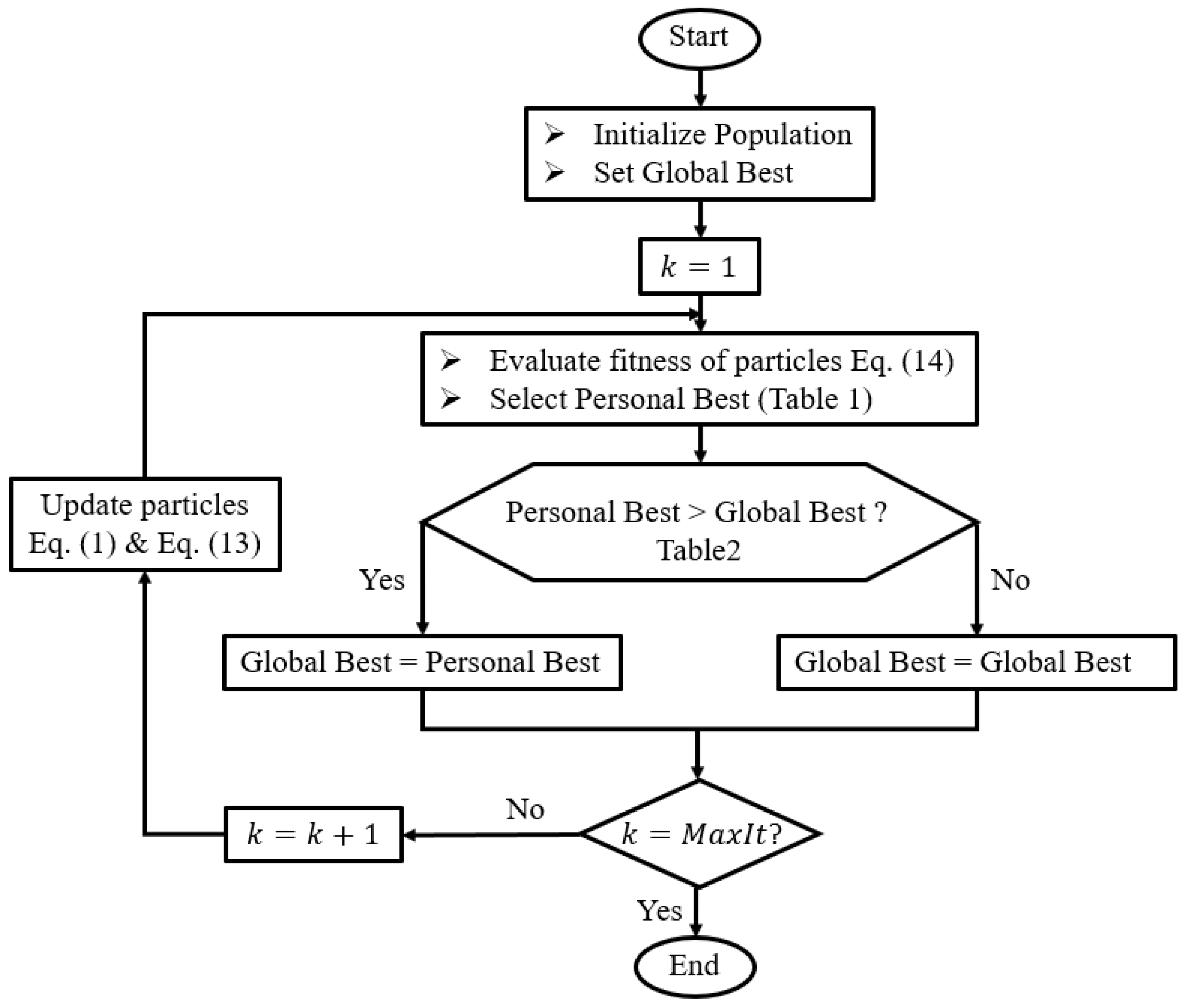
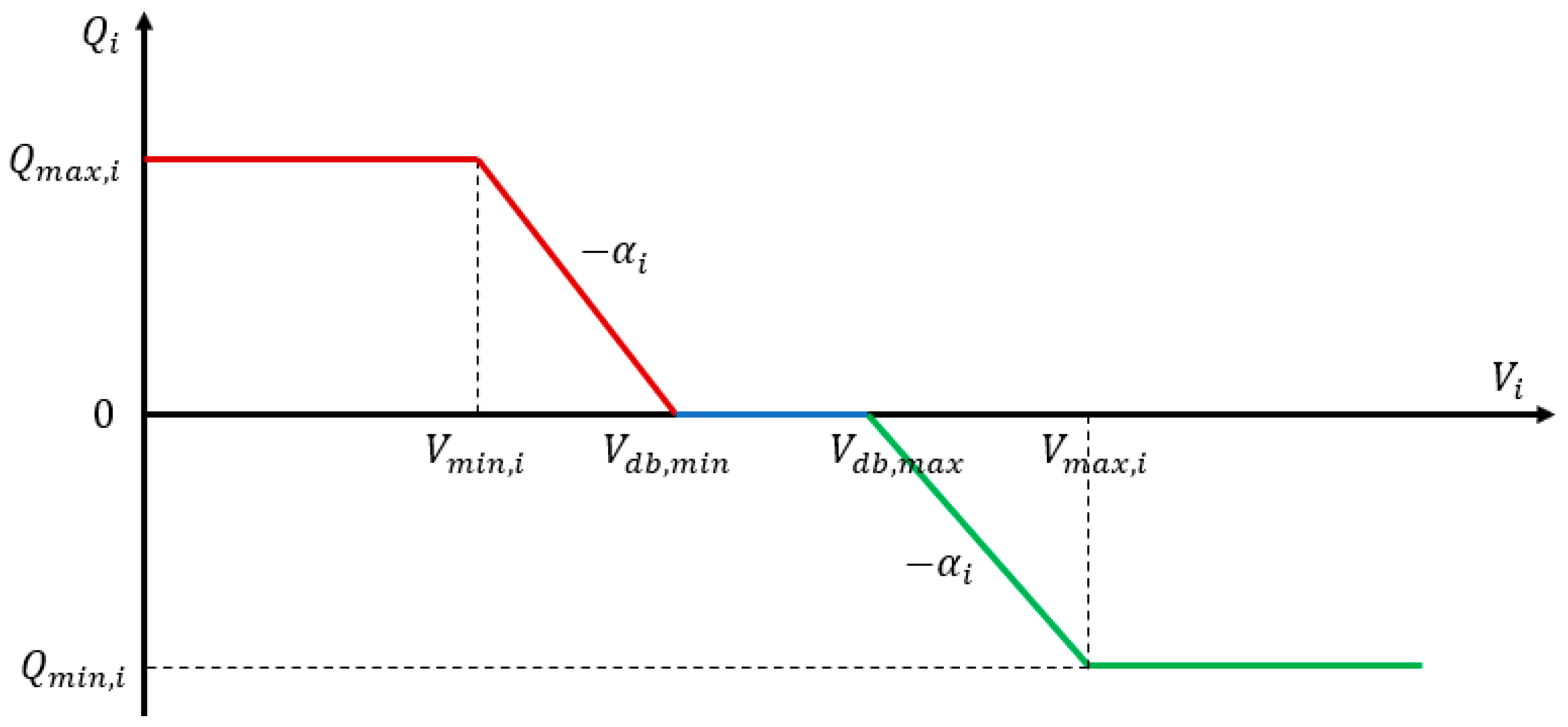
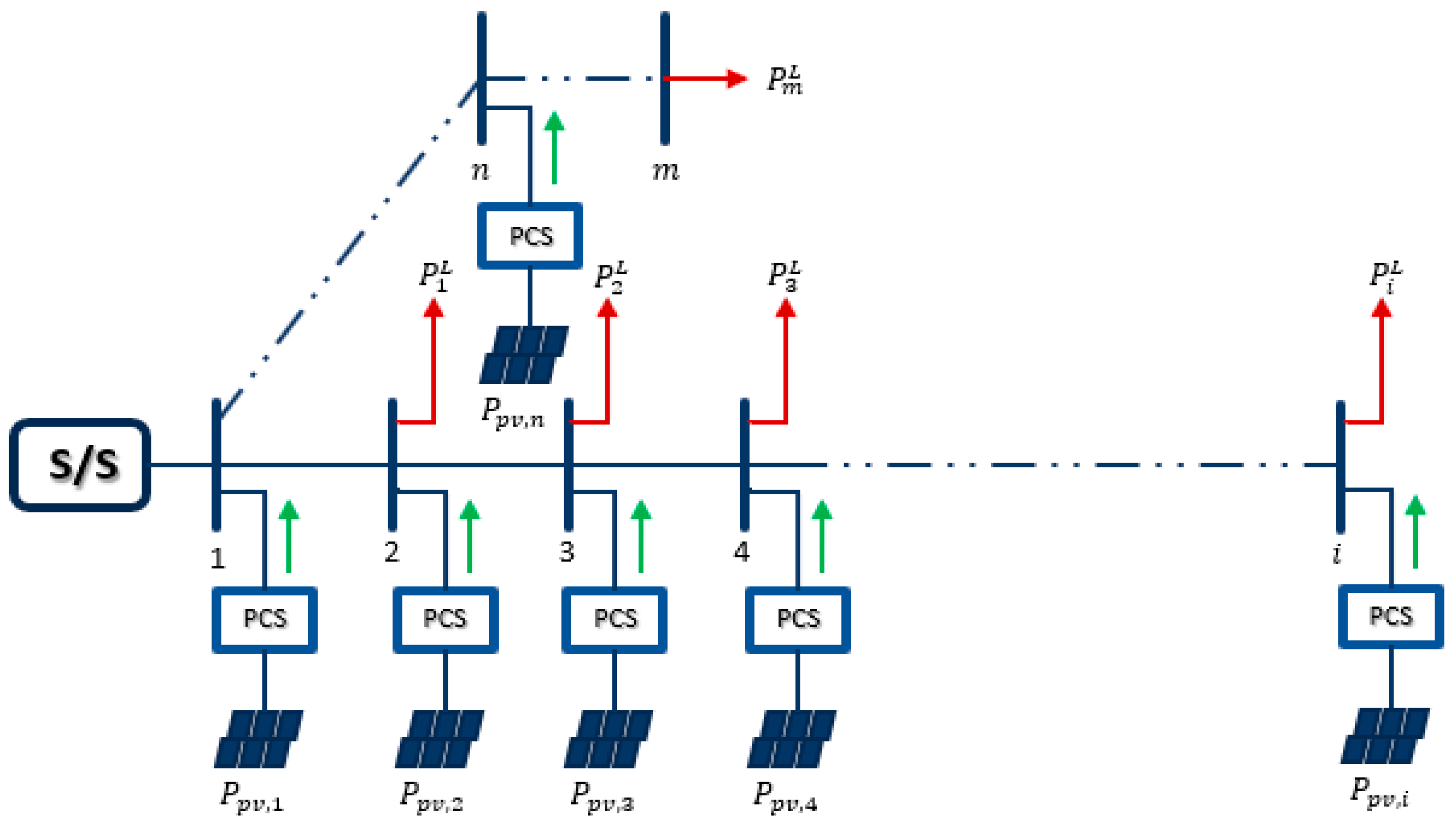


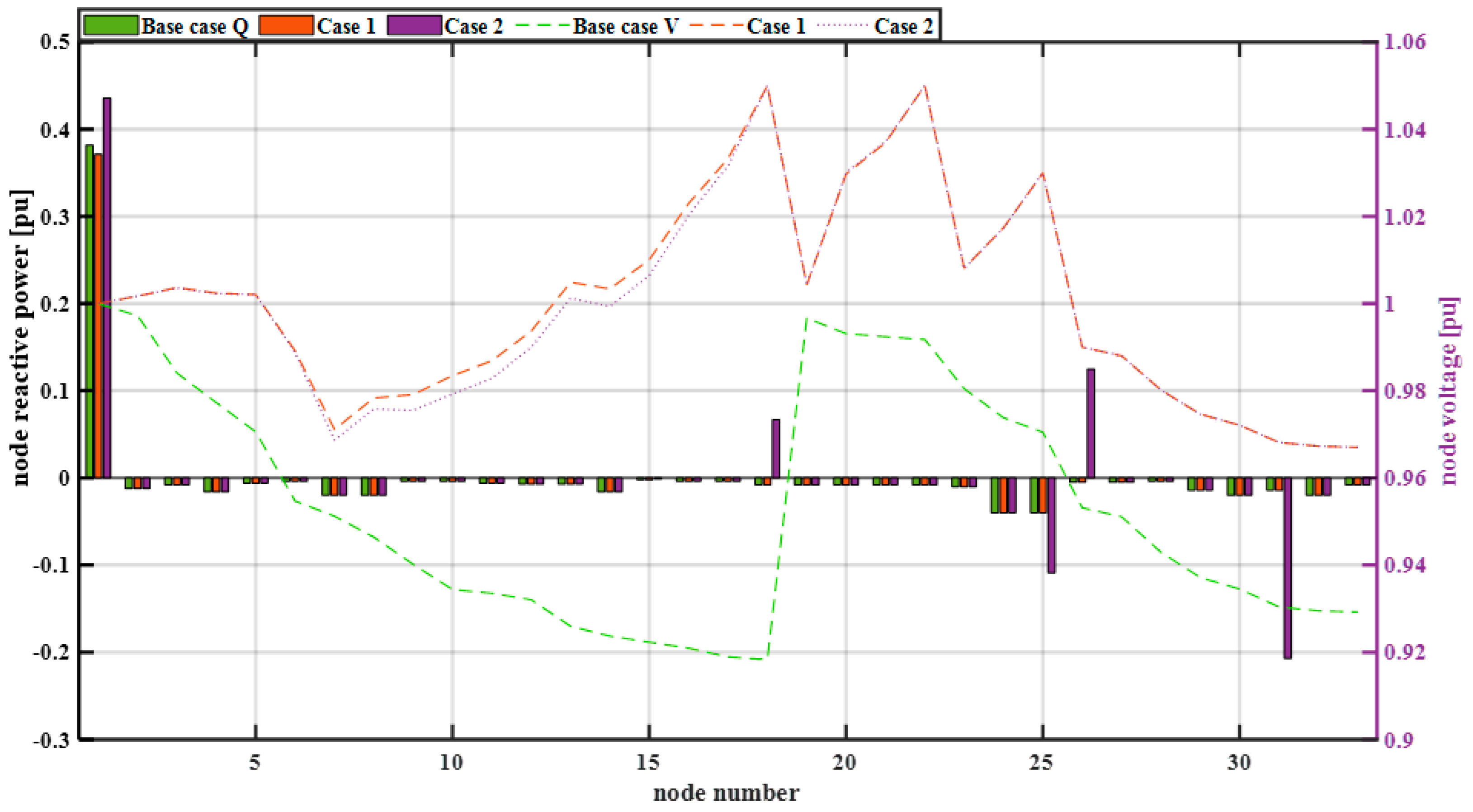
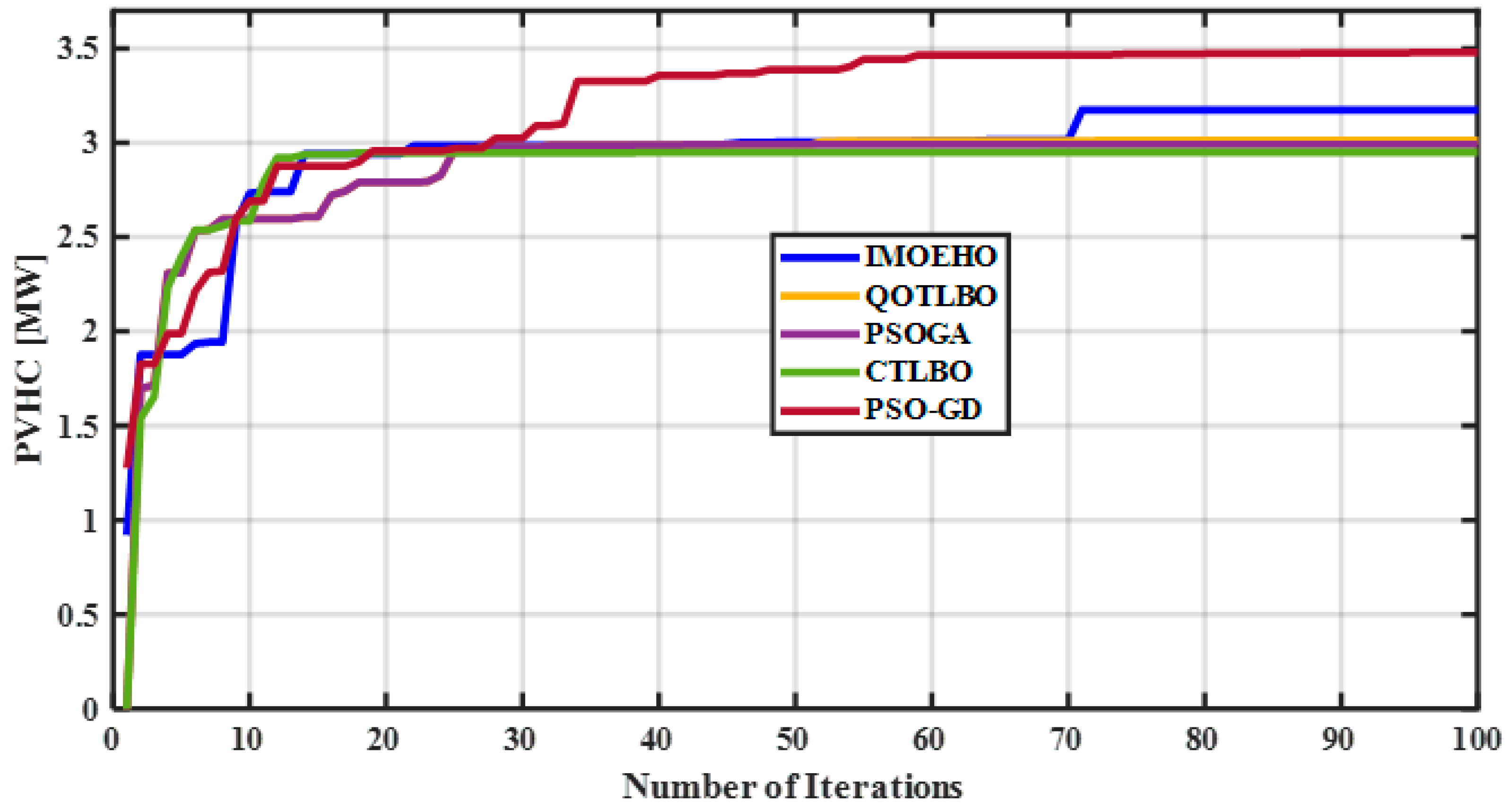
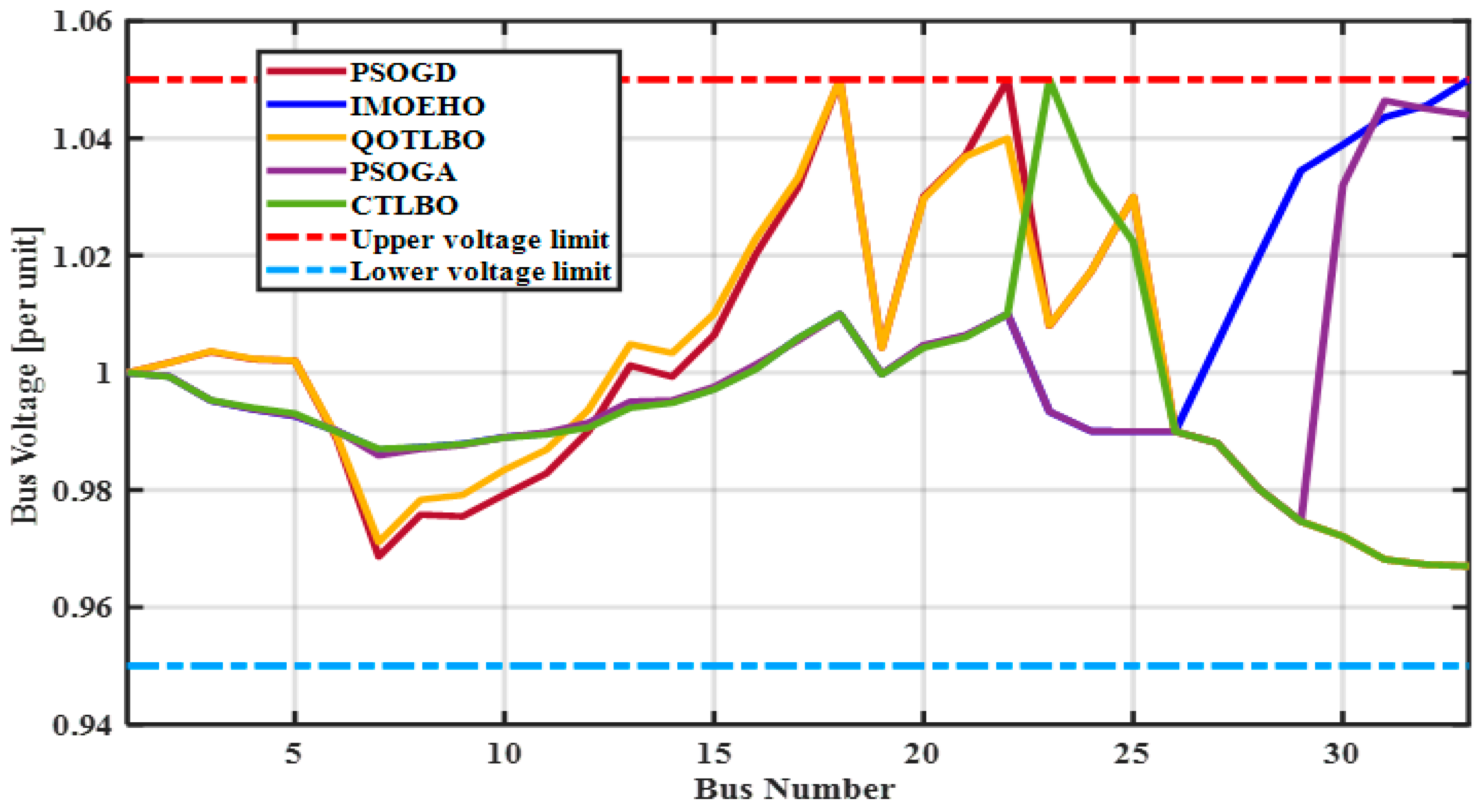


| Selection of the Personal Best Particle in the Population at Iteration k |
|---|
| A particle is superior to another if: |
|
| Selection of the Global Best Particle |
|---|
| A personal best particle is superior to global best particle if: |
|
| Location (Node #) | Installed PV [kW] | |
|---|---|---|
| Without VVC | With VVC | |
| 7 | 566.31 | 606.56 |
| 15 | 776.16 | 832.62 |
| 18 | 645.23 | 672.14 |
| 25 | 370.11 | 374.52 |
| 26 | 189.38 | 209.72 |
| 31 | 726.78 | 764.63 |
| TOTAL | 3273.97 | 3460.19 |
| Method | PV Locations | Hosting Capacity [MW] |
|---|---|---|
| CTLBO | 13, 25, 30 | 2.9511 |
| PSO-GA | 11, 16, 32 | 2.9910 |
| QOTLBO | 12, 24, 29 | 3.0142 |
| IMOEHO | 7, 14, 25, 31 | 3.1760 |
| PSO-GD | 7, 18, 22, 25, 26, 31 | 3.4619 |
| Test Case | [MW] | [MW] |
|---|---|---|
| IEEE-33 bus | 3.4310 | 0.0084 |
| IEEE-69 bus | 3.3105 | 0.0075 |
Disclaimer/Publisher’s Note: The statements, opinions and data contained in all publications are solely those of the individual author(s) and contributor(s) and not of MDPI and/or the editor(s). MDPI and/or the editor(s) disclaim responsibility for any injury to people or property resulting from any ideas, methods, instructions or products referred to in the content. |
© 2023 by the authors. Licensee MDPI, Basel, Switzerland. This article is an open access article distributed under the terms and conditions of the Creative Commons Attribution (CC BY) license (https://creativecommons.org/licenses/by/4.0/).
Share and Cite
Zulu, E.; Hara, R.; Kita, H. An Efficient Hybrid Particle Swarm and Gradient Descent Method for the Estimation of the Hosting Capacity of Photovoltaics by Distribution Networks. Energies 2023, 16, 5207. https://doi.org/10.3390/en16135207
Zulu E, Hara R, Kita H. An Efficient Hybrid Particle Swarm and Gradient Descent Method for the Estimation of the Hosting Capacity of Photovoltaics by Distribution Networks. Energies. 2023; 16(13):5207. https://doi.org/10.3390/en16135207
Chicago/Turabian StyleZulu, Esau, Ryoichi Hara, and Hiroyuki Kita. 2023. "An Efficient Hybrid Particle Swarm and Gradient Descent Method for the Estimation of the Hosting Capacity of Photovoltaics by Distribution Networks" Energies 16, no. 13: 5207. https://doi.org/10.3390/en16135207
APA StyleZulu, E., Hara, R., & Kita, H. (2023). An Efficient Hybrid Particle Swarm and Gradient Descent Method for the Estimation of the Hosting Capacity of Photovoltaics by Distribution Networks. Energies, 16(13), 5207. https://doi.org/10.3390/en16135207







